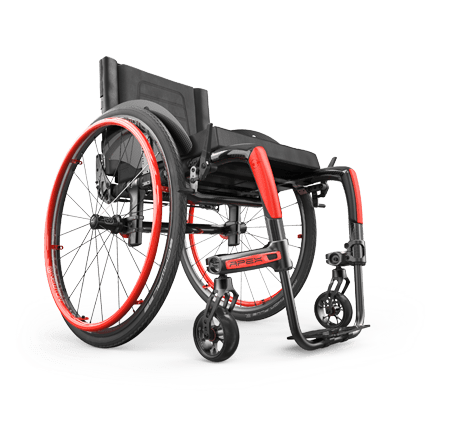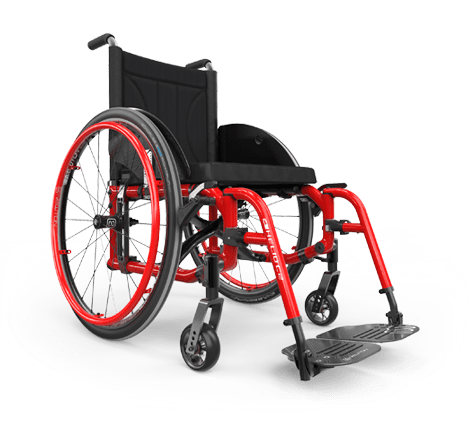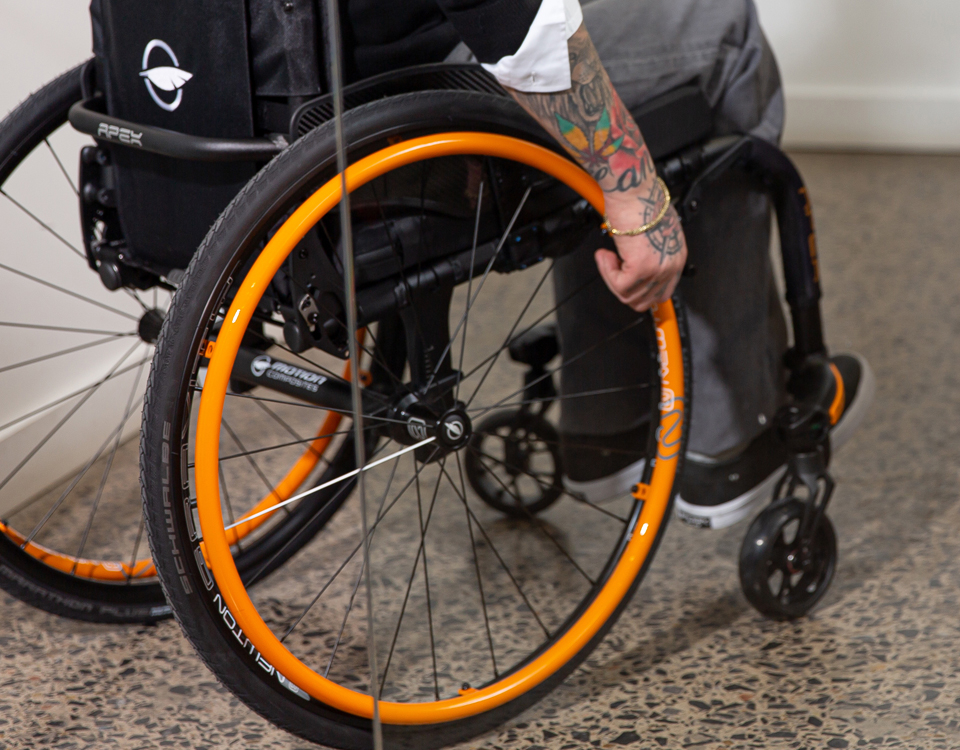Functionally rear wheels are critical components in manual wheelchair configuration and performance. They are two of the four points of the wheelchair that come in contact with the environment (along with front casters) and they are the instrument through which independent manual mobility happens! If you look at the complete configuration, rear wheels consist of three components: the wheel itself, the tire and the handrim. Here we will dive deeper into the variety of specific wheel properties and how they can impact performance for the user.
Size
The size of a rear wheel can have an effect on performance for many reasons. Size can dictate rear seat to floor height; the larger the wheel the higher the potential rear seat to floor height, depending on where it is placed with respect to the wheelchair frame. This can be important to ensure proper access to one’s environment and should be considered when working with very tall clients.
This height and size can also impact the users’ access to the wheels and upper extremity position during propulsion. Remember, that ideally, we want elbow flexion of 60-80 degrees when the users hand it at the top of the handrim for the most efficient propulsion stroke. The size and position of the rear wheel will impact this.
Generally, a larger wheel can increase propulsion efficiency as it allows longer contact with the rim during the active phase of a propulsion stroke and well as a larger area of contact are with the ground for traction. A larger wheel diameter will effectively roll farther with each push, minimizing the number of pushes per day. Size can also have an influence on maneuverability within the environment, a larger diameter rear wheel makes maneuvering on rougher terrain easier due to its enhanced ability to climb objects but, depending on its position within the wheelchair frame, can make the wheelchair footprint slightly larger making it difficult to navigate very tight spaces, but with proper set-up this could be avoided. Typical rear wheel sizes for a manual wheelchair will range from 20”-26” in diameter, 24” being the most common. You should consider both accessibility and propulsion efficiency when selecting the appropriate size.
Weight
Just like all components for manual wheelchairs, weight can be a significant factor when considering rear wheels. During independent propulsion the rear wheel is the component which is manipulated to move. Due to physics principles, such as inertia, an object that is heavier will take more effort to start moving and to stop when it is in motion. Research tells us that 63% of the manual wheelchair users movement patterns are typically short and slow bouts of movement. The majority of these bouts are shorter than 30 seconds, shorter than 13 meters and slower than 0.5 meters per second. This tells us that manual wheelchair users, similar to people who are ambulatory, start and stop a lot. The lighter the rear wheel, the less force it will take to start and stop the wheel, which can have a positive impact on the upper extremities and improve energy expenditure throughout the day.
The weight of a rear wheel can vary based on design, materials and size. However, when considering weight of a rear wheels we also need to consider the weight of the tire and the handrim we add to the wheel, as these components can also vary in weight. Remembering that it all adds up will help us make conscious decisions with our clients for the best balance between weight and performance.
Design
When looking at the design aspect of a rear wheel we want to select features that are going to provide the performance we want for an individual user. Specifically, we look for the stiffness of a wheel when determining efficiency. Flex within a wheel will decrease efficiency as the energy from propulsion is being lost in the unwanted movement of the wheel. Ideally there is high energy transfer from propulsion to the wheel, this will decrease propulsion rate preserving upper extremities.
The two most common categories of rear wheels are mags wheels and spoked wheels.
Mag Wheels
Mag wheels are usually molded of various composite materials. While often a common selection for lower-end manual wheelchairs they tend have more flex within the structure, therefore increasing the energy needed to propel the wheelchair. Also, due to their design mag wheels can warp overtime and this cannot be fixed. Mag wheels are also significantly heavier than spoked wheels and can add up to two lbs (1 kg) per pair as compared to a standard spoke wheel.
More recently, there are higher-performance mag wheels on the market which are composed of lighter and stronger materials to negate some of the negative effects of a traditional mag but even still they tend to be heavier and less efficient than a spoke wheel. The benefit for some users of a mag wheel, is the lack of maintenance required. However, we do have to remember that since Mag wheels have tendency to warp, they do need to be examined and replaced over time.
Spoke Wheels
Consisting of a rim, spokes and hub a spoke wheel is the gold-standard for independent propulsion. Due to their design, they are lighter and have less flex, increasing propulsion efficiency for the user. Within this category of rear wheels there are many options to be considered. Each of these options can influence the weight, durability and efficiency.
Rims: Wheel rims can be composed of a variety of materials such as steel, aluminum alloys or performance materials such as titanium, magnesium or carbon fiber. Each material has a different balance between weight, durability and other properties such as vibration damping. These higher-end materials allow for an increased stiffness to weight ratio and added strength. Wheel rims are categorized in terms of single, double and or even triple wall. This refers to the number of layers the rim is composed of and can impact strength.
Spokes: The number of spokes and the material can impact stiffness and durability. Durability is also determined by the way a spoke attaches to the rim at the hub(center) of the wheel. All spokes should be at the same tension, being ‘true’, to allow the wheel to roll straight and efficient.
- Materials: Spokes come in a variety of materials including steel, aluminum, carbon fibre, titanium and fibers such as Spinergy’s patented PBO™ Spoke. All materials come with their ratios of weight and durability but also esthetic and design, some even allow colour choices.
- Quantity: The more spokes the wheel has the less the load is across the hub, spokes and rims which typically improves strength and stiffness. Increasing the number of spokes on the wheel is one way to increase durability and reliability but can come with a weight disadvantage. However, fewer spokes can impact wheel stiffness.
- Attachment: Spokes attach to the wheel with a special nut called a nipple. Nipples allow adjustment in spoke tension which is how you can ‘true’ a wheel. Spokes have two ways of attaching to the hub of the wheel, J-bend or straight pull.
J-bend spokes are the more traditional option, with a 90-degree bend at the hub which looks like the letter 'J’, whereas straight pull spokes have no bend. Straight pull spokes are more durable as they can have a higher tension; the bend in the J style can be a weak point.
There is a perception that spoke wheels require a lot of maintenance, but it really dependent on how the chair is being used. For example, a user who is often on rough terrain, frequently jumping off elevations or extreme lateral movements may be required to tune their spokes more often to ensure the wheel is true. For a typical active user, maintenance of spoke wheels would not be an issue, especially when compared to the trade-off of increased efficiency and performance.
Cost
When it comes to cost of a rear wheel there is a large price range. Typically, a manual wheelchair will have a standard no-cost option available, that may have few performance features and may be offered in limited sizing options. Most manual wheelchair manufacturers will offer a variety of options for rear wheel upgrades including ultralight wheels, such as the Motion Composites Newton Gravity wheels, or wheels from after-market companies such as the popular Spinergy wheels. These upgraded wheels offer more performance characteristics but can also cost more. For example, the Newton Gravity from Motion Composites, a light weight, high-strength, aluminum rim with stainless steel spokes is approximately $350, and the Spingery Blade, with carbon fiber rim and bladed PBO fiber spokes costs approximately $1500. Despite added costs rear wheels are a feature that can have an impact on propulsion and efficiency and performance and should be considered carefully for all users.
Due to the wide variety of properties which can make up a rear wheel it is easy to understand how there are numerous options to choose from. Whether it is the wheelchair manufacturers standard wheel or an after-market wheel, matching the features to the users’ goals will help us ensure we have a good match to maximize performance.
References
- Sonenblum, S., Sprigle, S., & Lopez, R. (2012). Manual Wheelchair Use: Bouts of Mobility in Everyday Life. Rehabilitation Research and Practice, 2012, 753165–753167. https://doi.org/10.1155/2012/753165
- https://www.cyclingabout.com/the-best-rims-for-bicycle-touring/)
- https://www.bikeexchange.com.au/blog/mountain-bike-wheels-what-to-know







